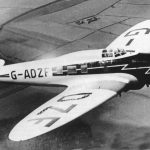As part of our ongoing series Today in Aviation History, we discuss the first flight of the U.S. Navy’s first purpose-built anti-submarine warfare (ASW) carrier-based aircraft to enter service, the Grumman AF Guardian, which made its first flight on December 19, 1945. While not as famous as other aircraft produced by Grumman during this time, it still played a silent role in the early days of the Cold War.
During World War II, the US Navy had no purpose-built anti-submarine warfare aircraft, with pre-existing aircraft such as the Consolidated PBY Catalina flying boat and the Grumman TBF Avenger torpedo bomber being used to hunt and sink German and Japanese submarines. Added to this was the fact that larger carrier-borne aircraft with bigger payloads were expected to fill the decks of the upcoming Midway-class carriers. However, Grumman had received an order for a new torpedo bomber. Grumman submitted two twin-engine designs, the XT2F and the XTSF, but these were both rejected during the mockup phase of development due to concerns over production and the practicality of operating twin-engined aircraft from smaller carriers then in service with the fleet. Grumman’s answer was the Model G-70, which was to be propelled by both a Pratt & Whitney R-2800 Double Wasp and a Westinghouse 24C jet engine (later called the J34). When it was clear the J34 needed more time in development, the Westinghouse 19XB (later the J30) was substituted, and this was the jet engine with which the first prototype, XTB3F-1 Bureau Number (BuNo) 90504 took off of its maiden flight, albeit under piston power only, as the tail-mounted jet showed reliability issues, and was later stricken from the design altogether.

It was also at this time when the Navy, seeing that multirole aircraft such as the AD Skyraider that could dive bomb and deliver torpedoes were the future of naval aviation, ordered the XT3F-1 to become an anti-submarine aircraft, being redesignated as the AF Guardian to reflect this change in mission profile. Since the onboard radar and sonar units necessary for this task were too heavy for one aircraft to carry alongside the ordinance necessary to sink a submarine, two variants were developed simultaneously: the first was the AF-2W “guppy” (hunter) with a total of three crew members, a ventral radome for an AN/APS-20 search radar, and AN/APR-98 electronic countermeasures (ECM) receiver and an AN/AP-70 bearing indicator. The second variant was the AF-2S “scrapper” (killer), retaining the XT3F-1’s bomb bay, while adding a third crewmember, a searchlight, and short-range radar. The hunter and killers were assigned to the same anti-submarine (VS) squadrons and would operate in tandem to seek out and destroy enemy submarines, which were likely to bee of Soviet origin.
The AF Guardian entered fleet service on September 27, 1950, and was the largest single-engine airplane in the world when introduced. Guardians would conduct maritime patrols during the Korean War, but while none were lost to enemy action, the Guardian had poor low-speed handling characteristics, being regarded as underpowered and heavy on the controls. This, combined with the fact that they routinely operated from small deck aircraft carriers, resulted in a high accident rate that made the aircraft unpopular with its flight crews. Later in 1952, the AF-3S was introduced. This was a “hunter” Guardian fitted with a magnetic anomaly detector (MAD) for the detection of submerged submarines. In all, 389 Guardians of all variants were produced, and they were not exported outside the US Navy.
With the introduction of the Grumman S2F Tracker, a twin-engine design that combined the roles of hunter and killer, the Guardians were relegated to reserve squadrons until they were all retired in 1957. After their retirement from the US Navy, a handful of AF-2S Guardians were modified to become civilian fire tankers, primarily with Aero Union of Chico, California, where they would fight forest fires during the California fire season.
Today, there are four surviving examples of the Grumman AF Guardian at museums across the United States, all of them being of the AF-2S model, and all of them were former fire tankers after their Navy service. BuNo 123100 is on display at the National Naval Aviation Museum in Pensacola, Florida. BuNo 129233 is displayed at the Pima Air and Space Museum in Tucson, Arizona, still in its Aero Union fire-fighting configuration. BuNo 126731 is on static display at the Arizona Wing of the Commemorative Air Force in Mesa, Arizona. Finally, BuNo 123088 is undergoing restoration at the Chico Air Museum in Chico, California, where it once operated out of as a fire tanker.
Although it was not the most successful aircraft of the post-WWII US Navy, the Grumman AF Guardian serves as a reminder of an era of transition for US naval aviation from the needs of WWII carrier aviation to the changing needs of the early Cold War. It also helped pave the way for new ASW aircraft to continue the mission of patrolling the seas for threats from below.
Today in Aviation History is a series highlighting the achievements, innovations, and milestones that have shaped the skies. All the previous anniversaries are available HERE



































